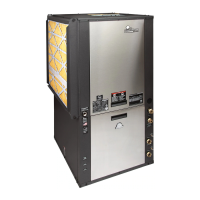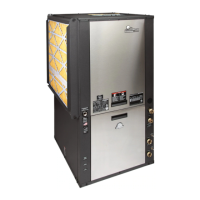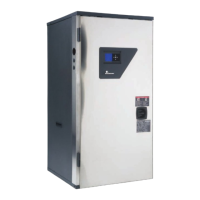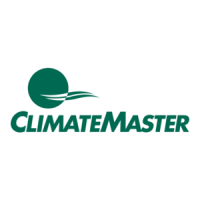Do you have a question about the ClimateMaster Tranquility 30 Series and is the answer not in the manual?
Steps to prepare units for installation, including checking electrical data and components.
Unit placement guidelines for indoor areas, avoiding freezing and condensation.
Instructions for suspending horizontal units using hanger kits and threaded rods.
Steps to convert the unit's air discharge from side to back.
Instructions for converting discharge from back to side.
Information on return air conversion limitations and unit rotation.
Guidelines for locating vertical units indoors, ensuring service access and avoiding adverse conditions.
Mounting instructions for the external flow controller.
Details on swivel fittings and leak-free seals for water connections.
Steps for locating and marking underground utilities before loop installation.
Guidelines for closed-loop piping materials and pressure testing.
Details on open loop systems, piping materials, and water quality considerations.
Guidance on sizing pressure tanks and pumps for heat pump systems.
Placement and function of water control valves to prevent mineral precipitation.
Methods for achieving proper flow regulation in heat pump systems.
Control of HWG by sensors and microprocessor, and DIP switch functions.
Requirements for matching available power to unit specifications.
How to connect incoming line voltage wires to the contactor.
Information on switching transformers for 208V operation.
How to change blower fan speed by moving wires on the terminal block.
Wiring thermostats directly to CXM or ECM interface boards.
Field selection of low water temperature limits using JW3 jumper.
Connecting accessory devices like water valves to the CXM control terminal "A".
Using external solenoid valves for water shut-off and reducing water hammer.
Using parallel valves for two-stage units to limit water use.
Guidelines for thermostat placement and wiring to the control board.
Determining cooling CFM based on tap settings, avoiding air coil freeze-up.
Determining heating CFM for TT and TS units based on tap settings.
Setting CFM for auxiliary/emergency heat modes.
Fine-tuning airflow adjustments using CFM adjust settings.
Field selection of humidity control modes for improved moisture removal.
Options for selecting test mode, DDC output, and UPS features.
Configuration options for water coil low temp limits, alarm relay, and DIP switches.
Safety features like anti-short cycle, fault retry, lockout, and pressure switch protection.
Environmental and operational limits for unit performance, including air and water temperatures.
Start-up conditions and minimum/maximum limits for building space conditioning.
Pre-power checks for unit components, wiring, loop/water piping, and controls.
Step-by-step procedure for starting up the unit and verifying operation.
Maintenance for water coils in direct ground water and other loop applications.
Maintenance for HWG coils, especially in hard water conditions.
Importance of clean filters for performance and maintenance schedule.
Cleaning and inspecting condensate drains to prevent plugging and overflow.
Annual checks for compressor amperage and fan motor dry operation.
Cleaning the air coil annually for maximum performance.
Maintaining cabinet integrity and servicing the refrigerant system.
Preliminary checks before referring to troubleshooting charts and verifying inputs/outputs.
General guidelines for troubleshooting the CXM control board by verifying inputs and outputs.
How to verify 24VAC inputs from the thermostat to the CXM board using a voltmeter.
Verifying sensor inputs and component outputs from the CXM board.
Entering and exiting test mode for checking CXM control operation.
Details the limited express warranty, labor allowance, and exclusions for residential products.
Specifies remedies for warranty breaches, including repair, replacement, or refund.
How to obtain warranty service and contact information.
Steps to prepare units for installation, including checking electrical data and components.
Unit placement guidelines for indoor areas, avoiding freezing and condensation.
Instructions for suspending horizontal units using hanger kits and threaded rods.
Steps to convert the unit's air discharge from side to back.
Instructions for converting discharge from back to side.
Information on return air conversion limitations and unit rotation.
Guidelines for locating vertical units indoors, ensuring service access and avoiding adverse conditions.
Mounting instructions for the external flow controller.
Details on swivel fittings and leak-free seals for water connections.
Steps for locating and marking underground utilities before loop installation.
Guidelines for closed-loop piping materials and pressure testing.
Details on open loop systems, piping materials, and water quality considerations.
Guidance on sizing pressure tanks and pumps for heat pump systems.
Placement and function of water control valves to prevent mineral precipitation.
Methods for achieving proper flow regulation in heat pump systems.
Control of HWG by sensors and microprocessor, and DIP switch functions.
Requirements for matching available power to unit specifications.
How to connect incoming line voltage wires to the contactor.
Information on switching transformers for 208V operation.
How to change blower fan speed by moving wires on the terminal block.
Wiring thermostats directly to CXM or ECM interface boards.
Field selection of low water temperature limits using JW3 jumper.
Connecting accessory devices like water valves to the CXM control terminal "A".
Using external solenoid valves for water shut-off and reducing water hammer.
Using parallel valves for two-stage units to limit water use.
Guidelines for thermostat placement and wiring to the control board.
Determining cooling CFM based on tap settings, avoiding air coil freeze-up.
Determining heating CFM for TT and TS units based on tap settings.
Setting CFM for auxiliary/emergency heat modes.
Fine-tuning airflow adjustments using CFM adjust settings.
Field selection of humidity control modes for improved moisture removal.
Options for selecting test mode, DDC output, and UPS features.
Configuration options for water coil low temp limits, alarm relay, and DIP switches.
Safety features like anti-short cycle, fault retry, lockout, and pressure switch protection.
Environmental and operational limits for unit performance, including air and water temperatures.
Start-up conditions and minimum/maximum limits for building space conditioning.
Pre-power checks for unit components, wiring, loop/water piping, and controls.
Step-by-step procedure for starting up the unit and verifying operation.
Maintenance for water coils in direct ground water and other loop applications.
Maintenance for HWG coils, especially in hard water conditions.
Importance of clean filters for performance and maintenance schedule.
Cleaning and inspecting condensate drains to prevent plugging and overflow.
Annual checks for compressor amperage and fan motor dry operation.
Cleaning the air coil annually for maximum performance.
Maintaining cabinet integrity and servicing the refrigerant system.
Preliminary checks before referring to troubleshooting charts and verifying inputs/outputs.
General guidelines for troubleshooting the CXM control board by verifying inputs and outputs.
How to verify 24VAC inputs from the thermostat to the CXM board using a voltmeter.
Verifying sensor inputs and component outputs from the CXM board.
Entering and exiting test mode for checking CXM control operation.
Details the limited express warranty, labor allowance, and exclusions for residential products.
Specifies remedies for warranty breaches, including repair, replacement, or refund.
How to obtain warranty service and contact information.
| Brand | ClimateMaster |
|---|---|
| Model | Tranquility 30 Series |
| Category | Heat Pump |
| Language | English |












